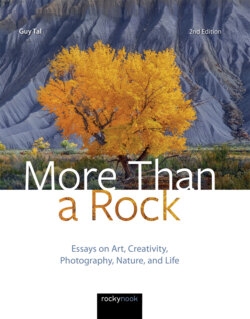Читать книгу More Than a Rock, 2nd Edition - Guy Tal - Страница 18
На сайте Литреса книга снята с продажи.
9The Meaning of Words
ОглавлениеI try to apply colors like words that shape poems, like notes that shape music.
—Joan Miró
A fellow photographer I respect and with whom I corresponded in the past wrote to say that he was not comfortable with one of my essays in which I drew a distinction between documentary photographs and fine-art photographs (his terms, not mine), both of which I believe to be overloaded and difficult terms to define in an absolute way.
A topic I routinely explore and write about is the general lack of acknowledgment of categories within the larger realm of photography. Think, for example, about writing. Readers have no problem applying different frameworks of appreciation and judgment to novels, essays, news reports, poems, or other uses for written words; painting aficionados readily distinguish between the abstract and the realistic, and numerous subgenres in between. In photography such separation is not quite so well established. To many viewers, all products of a camera are judged by a single criterion, as if they are intended to accomplish but one purpose: to accurately record the appearance of things as anyone present at the scene may have seen them. I attribute such lack of sophistication to the fact that our medium is relatively young and, to a significant degree, also a victim of much prejudice. Certainly, we can all think of exceptions, and so it is my hope and belief that a more nuanced mode of thinking will evolve in due time.
The word “art,” derived from the Latin artem (same as artifact and artificial) and referring specifically to the products of manual skill, was explicitly coined to describe aesthetic objects produced by application of craftsmanship. Put another way, the very word art describes something that is not naturally or spontaneously occurring, but rather something manufactured. Over the years, the term art came to be associated with a staggering array of items, from calligraphy to strategies of war; from pottery to video games; from engraving to managing a business; from exquisite ornaments to an autographed urinal; etc. In our time, it seems that the only definition of art still standing (and articulated by various thinkers) simply is: anything that is presented as art. While perhaps true, such a definition is of little practical use as it can no longer be used to delineate between what is art and what is not art, nor be applied in any consistent way.
With that in mind, I am now very reluctant to use the term art in my writing. Instead, I make the separation between representational photography and creative photography. By today’s definition, both can be considered art; however, by making this distinction I also can return to the original intent of distinguishing human-crafted creations from naturally occurring phenomena that are literally re-presented to an audience. Also, by making this distinction, I avoid the prickly topic of associating value with either term. The fact that an image is representational or creative does not, in itself, imply that one is more elevated than the other, as both may manifest in exceptional or mediocre work, or anything in between.
I characterize my work as creative explicitly to suggest that it may deviate from “the way it really looked,” because I want there to be a sharp and honest division between reality and artifice. I care very much about the reality of the things I photograph, and I believe that to conflate this reality with the limitations of what may be expressed in a photograph most often leads to the diminishing of the former rather than the elevation of the latter. This is because such conflation always requires a degree of misrepresentation.
A creative image is not a record of a scene nor a substitute for a real experience; it is an experience in itself—an aesthetic experience—something the artist has given the world, rather than a contrived view of something that already existed independent of the artist.
